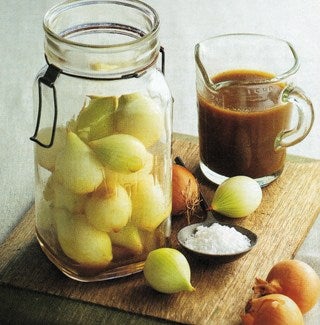Pickled Onions
Following last month's feature about jams, I thought we'd look at pickled vegetables.

Pickled Onions
Breathes there a man with nose so dead
Who never to himself has said:
'One pickled onion, one shallot,
Would raise this dish to what it's not'?
Oscar Mendelsohn, "A Salute to Onions" 1966
Following last month's feature about jams, I thought we'd look at pickled vegetables. Many vegetables can be preserved by pickling, but there's little doubt that onions are the most popular, although it's one of those foods that you either love or hate! You can, of course, buy pickled onions, including the tiny little silverskin cocktail variety, but doing it yourself enables you to choose your variety and add your own flavourings, to make them spicy, sweet or hot for a variety of uses.
There are two main varieties readily available for pickling, pickling onions and shallots. The former are just small main crop onions, and have a strong taste, while shallots are approximately the same size or a bit larger, with skin colour ranging from coppery yellow to reddish brown. Usually the bulbs, formed in several clusters, are oval in shape. Shallots have a more delicate, sweet flavour than main crop and are popular in French and Asian cookery, and they are most readily available in late summer although still around between February and July. With both pickling onions and shallots, look for firm flesh and dry, papery outer skins – no green shoots.
The great thing about pickling onions is that there is no cooking involved – the hardest thing is peeling them. Don't cut too much off the ends, otherwise while they are maturing, they will disintegrate with the inside leaves slipping out. It doesn't make any difference to the flavour but spoils the appearance. Yellow spotting can occur in onions after lengthy storage, for no apparent reason, but it doesn't cause any harm in the eating.
Leave both onions and shallots to mature for at least 2-4 weeks before eating, but remember that the longer the storage, the better the flavour, if you can keep the family away from them!
Tip for pickling onions from my mentor, Tui Flower – when they've been left to stand in salt water (brine) for 24 hours, drain, rinse in cold water, put in clean jars, then turn the jars upside down on thick paper (newspaper's fine, or kitchen paper) to drain for a further 24 hours before turning them right way up and adding spices to taste and vinegar – the extra time to drain keeps the onions really crisp and crunchy. Remember that your choice of vinegar will influence the look of the vegetables – white, white wine and cider vinegars give clear pickles; malt vinegar and red wine vinegar discolour them. The spices you use will determine whether the onions are hot or mild – personally I prefer plain pickled onions with just peppercorns, cloves and a chilli.
One of the most popular recipes that ever came out of Tui Flower's Test Kitchen at NZ News many years ago was for Pickled Onions in Curry Sauce, and I have purloined it to pass it on to you as the book it was in is long out of print and by now the recipe has probably been handed down through a couple of generations!
1 kilogram pickling onions
¼ cup salt
4 cups water
2½ cups malt vinegar
1 cup brown sugar
1 teaspoon ground cloves
1 teaspoon ground all spice
1½ tablespoons flour
1 teaspoon dry mustard
2 teaspoons curry powder
1 teaspoon turmeric
¼ cup vinegar
Peel onions. Dissolve salt in cold water. Pour over onions and leave in non-metallic bowl for 24 hours.
Put first measure of vinegar and brown sugar in to saucepan and bring to boil. Combine cloves, allspice, flour, mustard, curry powder, turmeric and second measure of vinegar to smooth paste. Add mixture to saucepan and cook until it thickens, stirring frequently. Drain onions and pack into hot jars. Pour sauce over onions to completely cover. Seal. Store for at least 1 month before using.
Makes 2 x 1 litre jars.


Comments (0)
Please login to submit a comment.